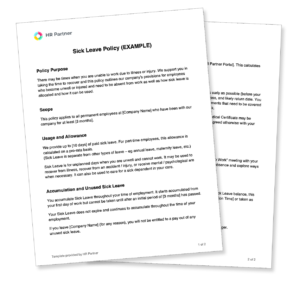Workplace absenteeism is costly at the best of times, but with the ongoing impacts of the pandemic, as well as local increases in the incidence and severity of flu issues, it’s never been a greater challenge than now. Not only does this have a direct productivity cost, but the ripple effects are perhaps even more significant. These can include the impact of missed work on customers and the company reputation, the extra pressure on other team members, and the impact on the company culture.
Of course, we can understand the reasons behind absenteeism in these times, but what can leaders actually do to alleviate this and reduce the impact of employee sickness on the business operations? There’s no magic bullet, but these 5 things will help…
1) Have a clear Sick Leave / Absenteeism Policy
A solid Sick Leave policy should be one of the core HR policies for your company. It needs to state the expectations for employee absences, instructions on how to report absences, details on how the company will follow up, and also the consequences of excessive or unexplained absences. It should also state in which scenarios it will be necessary to provide a medical certificate or statutory declaration.
Your Sick Leave Policy should be written in a way that shows compassion for genuine cases, but also acts as a deterrent against employees taking unnecessary absences. Keep in mind that it is usually better to have a policy that errs on the side of being strict that you can later make exceptions to, rather than having one that is too flexible upfront.
Once you have your Sick Leave Policy prepared, include it in a checklist for all team members to review and sign.

Download a Sick Leave Policy here
This is editable and can be configured to suit your company’s needs
2) Make it easy to See and Track Employee Leave
In most areas, it’s a legal requirement to accurately track all employee leave, yet surprisingly, a high proportion of businesses don’t have a reliable way of doing this. An HR system like HR Partner allows you to easily keep track of all types of leave, including sick leave. It provides an employee portal where team members can submit leave requests and see their leave history and balances. You can also elect for the leave calendar to be available for the department or whole company to see and this visibility of leave can help act as a deterrent against taking excessive leave.
There are also measures such as the “Bradford Factor” which can be used as an indicator of excessive absenteeism. This combines the number of unplanned absent incidences along with their duration of these, to give each employee a score which can help managers identify specific problems. Putting “attendance” or “absenteeism” onto the agenda for management meetings can also help highlight any issues that need addressing.
3) Coach Managers to Address Unplanned Leave Immediately
Whatever the reason for an employee being absent, managers should address all leave occasions immediately. In many cases, this can help provide support for the employee, demonstrate empathy, and may help employees with practical measures that will make their return to work more successful. However, for an employee that may have taken some liberties, the return to work interview will clearly show them that their absence was noticed and may encourage them to reduce their absenteeism.
For this reason, it can be a good idea to include a “Return to Work” meeting with a manager as part of the Sick Leave Policy.
Download a Sick Leave Policy Template now
This policy includes reference to the “Return to Work” meeting
A “Return to Work” discussion takes place once the employee returns to work. Their manager should sit down with them to have a conversation about what happened, why it happened, and what’s expected of them moving forward. Also make sure they know if their absence has triggered any type of disciplinary action or a performance plan. Where there is a repeat pattern of unplanned absences, there needs to be a clear source of action taken.
4) Focus on Employee Wellness
Companies can also address absenteeism by focussing on measures which improve employee wellness. During the current times, this might be information and means to reduce the likelihood of virus infections. But other things might include;
- Providing and encouraging flu shots
- Making stress management training available
- Encouraging employees to take their annual leave / vacation time – as regularly holidays can reduce the incidence of burnout
- Running wellness challenges / campaigns (eg daily step counts, meditation streaks, etc)
See more tips on How to create an Employee Wellness Program here.
5) Adapt to the New Reality
The workforce has changed dramatically over the last 2 years and the expectations of employees have shifted significantly. Rather than wait for things to ‘return to normal’, successful companies will use this period to reevaluate their work processes and policies and adapt to the new circumstances and mindsets. In fact, with competition for good employees being stronger than ever, companies that don’t adapt are likely to be left behind.
Some of the things we’re seeing companies innovate on include;
- Working from home arrangements – Many companies were forced to adopt this for a time, but a good proportion of employees prefer this and companies are making it part of a longer-term arrangement.
- Flexible working times – The notion of the 9 to 5 workday is disappearing for many companies with some requiring work during a few “core hours” but then allowing employees to complete their duties at times that fit in around their lives.
- Extra leave – With more of a focus on quality-of-life factors, companies that give their employees additional leave benefits are seen as preferred employers. This might be as simple as a day off for their birthday, extra holiday time based on their tenure, or a special type of leave for self-care.
- Customer expectations – We used to always say that “the customer comes first” but many companies have tweaked this to be something closer to “our team comes first, and the customer is a close second”. Customers can put team members under enormous pressure so having a philosophy that your employees’ well being is more important than any particular customer is an important factor in creating a strong culture, and eventually reducing absenteeism. Of course, absenteeism is very bad for customer service, so this ultimately does increase customer satisfaction anyway.
- Restructuring workload – If your team is operating at a reduced capacity because several people are away at any given time, it’s unrealistic to expect that output will remain unchanged. Instead, it pays to examine the priorities, reduce non-crucial projects, and restructure work so as not to overload the remaining employees.
While absenteeism might seem like something that is beyond the control of management, as you can see here, there are many measures that can be taken to reduce both the incidence and impact of absenteeism.
If you’d like to see how you can manage and track your Sick Leave and other types of leave in HR Partner, please book a complimentary demo with us now or see our Leave Management features here.


